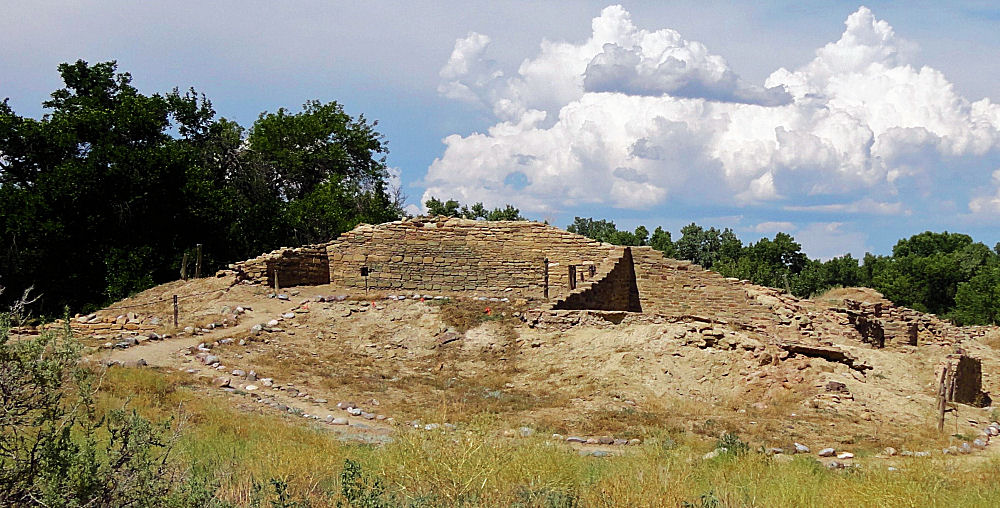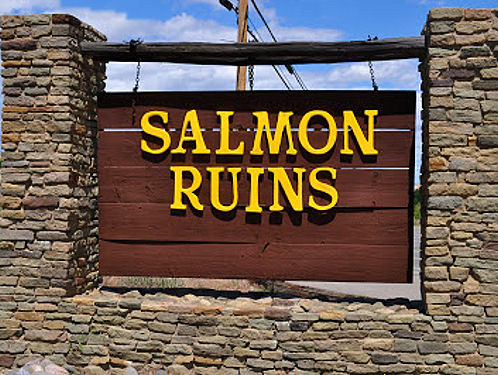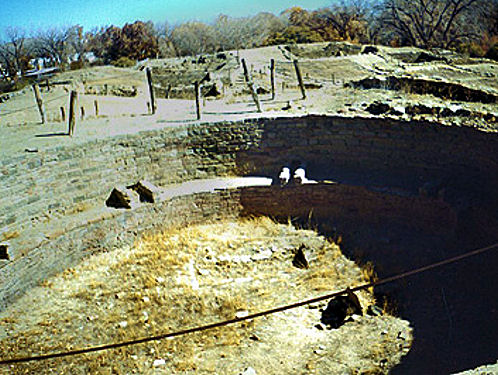



 |
| Salmon Ruins Museum and Research Library, New Mexico. Courtesy: Wikipedia, the free encyclopedia. |
|---|

Salmon Ruins Museum and Research Library:
We wish to thank Wikipedia, the free encyclopedia for some of the images and information on this page. We share information with Wikipedia.
Salmon Ruins is a site in the far northwest of the American state of New Mexico hosting a Chacoan Anasazi great house built between approximately 1088 CE and 1100 CE. The complex contained around 150 ground-level rooms arranged into a D-shaped profile; up to 100 second-floor rooms are estimated to have sat atop them. The complex was remodeled before being abandoned in the late 13th century. The pueblo is situated on the north bank of the San Juan River, just to the west of the town of Bloomfield, New Mexico, and about 45 miles (72 km) north of Pueblo Bonito in Chaco Canyon. The site is situated on an alluvial terrace above the river bottom. Construction and occupationTree-ring dates indicate that the main structure was built in a span of seven years from AD 1088 to 1095. The plan of the Salmon great house is very similar to that of the nearby Aztec Ruins. The site was abandoned by the Chacoan builders around 1150 and later re-occupied by Northern San Juan Anasazi peoples from the Mesa Verde area. A fire burned a large portion of the site in 1250 CE. A large number of children and one woman were killed when the kiva roof on which they were standing collapsed, causing them to fall into the burning kiva. Another large fire in 1270 CE destroyed the great kiva and much of pueblo. The site was abandoned permanently at some time after this date.
Anasazi settlements in North America started during the late 11th century and was used over a 200-year period, until around AD 1300. In about 1300 CE the Ancestral Pueblo people left the region, migrating southeast to join existing communities along the Rio Grande, south to the Zuni area, or west to join the Hopi villages in Arizona. The Anasazi are believed to most likely have moved from these ruins into neighboring areas such as the present day Hopi and Navajo reserves and the pueblos of the Rio Grande Valley. These relocations occurred due to drought or loss of nearby fertile land. History Of The Anasazi People: Archaeologists Say The Following:
By about 900 BC, Archaic people lived at Atlatl Cave and similar sites. By about AD 850, the Ancient Pueblo population�the "Anasazi", from a Ute term adopted by the Navajo denoting the "ancient ones" or "enemy ancestors"�had rapidly expanded across the San Juan Basin. Aztec Ruin National Monument features a village built by these Ancestral Puebloan people, sometimes called the Anasazi. The Anasazi inhabited Aztec Ruin anywhere between 550 to 1300 AD. These people were mainly subsistence farmers; they grew crops on nearby mesas. Their primary crop was corn, which was also was the major part of their diet. Men were also hunters which further increased their food supply. The women of the Anasazi were famous for the elegant basket weaving. Anasazi pottery is just as famous as their baskets; their artifacts, even today, are highly prized. Since the Anasazi kept no written records, their artifacts are the only link to understanding their interesting culture. By 750 AD, the Anasazi people were also building mesa-top villages made of adobe. By the late 12th century they began to build the cliff dwellings for which Mesa Verde in Colorado is famous. The cohesive Anasazi system began unravelling in about AD 1140, perhaps triggered by an extreme 50-year drought that began in about AD 1130. This chronic climatic instability, including a series of severe droughts, again struck the region between about AD 1250 to AD 1450. Architecture Of The Salmon Ruins: The walls of the Salmon great house are constructed of thin sandstone slabs in the Chaco Canyon style. The structure is generally rectangular in shape and is oriented with its long axis running northeast to southwest. The back, or north wall of the ruin is roughly 400 feet long. There are about 250 large rooms arranged into suites, perhaps as family dwelling units. Two room blocks extend southward from each end of the rear section, enclosing a large plaza. The plaza contains a great kiva similar to the one found at Aztec. There is also a "tower kiva", similar to the one at Chetro Ketl in Chaco, situated in the center of the main roomblock. The rooms are roofed with large wooden beams and stringers (also known as vigas and latillas) in the style of most ancient and modern pueblo structures. The logs used as beams were cut from ponderosa pine, Douglas fir and other large trees that had to be transported to the site from approximately 50 miles away. Dendrochronological samples taken from these beams indicate that the logs were cut between AD 1088 and AD 1093. The great kiva measures about 50 feet in diameter. The roof of the kiva was supported by four large columns built of alternating layers of stone and wood. There were other special function rooms in the site, including four milling rooms, and a room that may have served as a shop for making and repairing metates.
Salmon Ruins Museum and Research Library:
Summer Hours (May - October)
Winter Hours (November - April)
Salmon Ruins Museum
How To Get There:
Salmon Ruins Museum and Research Library is located on 6131 Highway 64 Highway 64, near the City of Bloomfield, New Mexico.
|
If you are planning to visit Salmon Ruins Museum and Research Library, New Mexico. And if you are coming from outside of New Mexico, you could fly into Albuquerque International Sunport (IATA: ABQ, ICAO: KABQ, FAA LID: ABQ) is a public airport located 3 miles (5 km) southeast of the central business district of Albuquerque, a city in Bernalillo County, New Mexico, United States. It is the largest commercial airport in the state, and then rent a car.
There are many hotels and motels in New Mexico and Colorado, and if you need a place to stay; Priceline.com can arrange that for you. We have personally, booked flights, hotels, and vacations; through Priceline.com and we can highly recommend them. Their website is also easy to use! We have some links to Priceline.com on this page since they can arrange all of your air flights, hotels and car. We of course, appreciate your use of the advertising on our pages, since it helps us to keep our pages active. Whenever you make a purchase from a link on our page we get credit for that transaction. Again, Thanks!
|
 |  |
| Salmon Ruins Museum and Research Library. | Salmon Ruins. Courtesy: Wikipedia, the free encyclopedia. |
|---|


